#should i include that its st anthony of padua?
Text
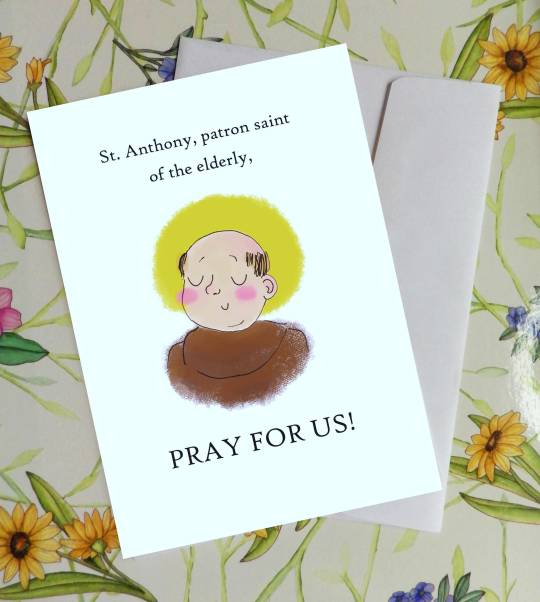

So I finally made this card real
#yes the pictures are edited since i haven't printed them yet but#happy birthday card#catholic card#should i include that its st anthony of padua?#eh#it's fine#or maybe i will fix it later
32 notes
·
View notes
Photo



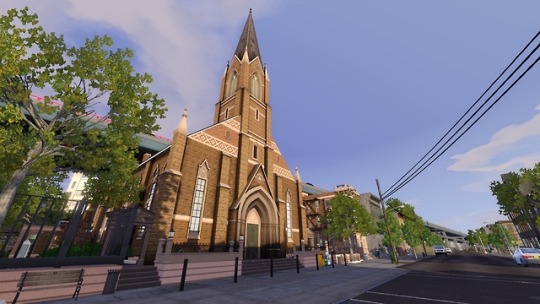
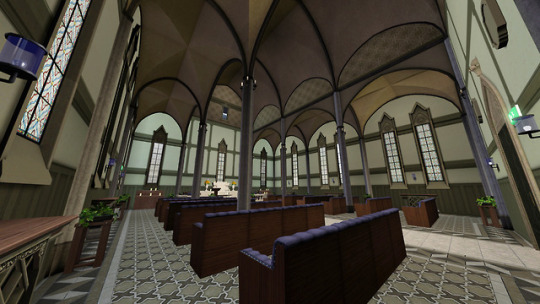



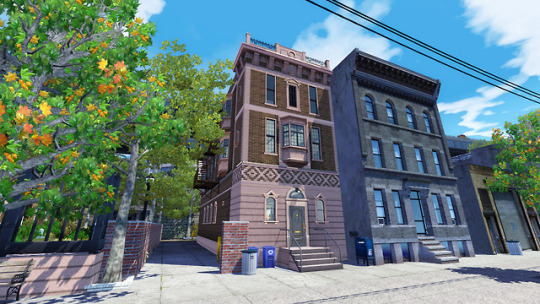

Boroughsburg CC Update 4
Previous updates here. Boroughsburg can be found here.
I always release worlds for free, but help me pay for medical and educational expenses! Every little amount is always greatly appreciated, with the large amount of time I put into these worlds in a busy schedule! - Potato Ballad Sims

CLICK HERE & HELP A POTATO OUT
This set focuses on Boroughsburg's church, right after Easter! See captions for more details!
Two new lots! The monumental Our Lady of the Plumbob Heart Church, and the Boroughsburg Parish House. These two are roughly based on St. Mary's in Hunters Point, Queens, and St. Anthony of Padua in Greenpoint, Brooklyn (and its adjacent Parish House).
The church is 40x30, and goes on 33 1st St. The Parish House is 15x30 and goes on 50 Badford Avenue.
Ten hand-crafted pieces of CC that makes this church (and your church) a church! These are fully recolorable and contain appropriate LODS. They can be found in Buydebug > Misc, though the windows can also be found in the Build > Windows category as well.
EPs used: WA, AMB, LN, GEN, PETS, SEASONS, UNI
The church utilizes a decrappified version of the Inflected Double Doors from the Last Venue of Amore.
The lots utilize some of Boroughsburg's props and Mspoodle's ceiling beams, which should be included in the main Boroughsburg download package. The roofs are Sookielee's EA-Match Roofs with White Trim, which I have included in the download as the original upload is gone.
Our Lady of the Plumbob Heart Church will have a window elevation issue when placed (because walls were placed at the edge of the lot), use constrainfloorelevation false to fix it. Same with the Parish House with the fire escapes and wall medallions.
If you’re using Buzzler’s Shell Emitters, you will need to set the shell sound emitter on the lot. The ShellSound is BuildingHero, and the offset is -300.
Download
Get it here.
Thanks @mspoodle1 for testing it out!
#caw#boroughsburg#sims 3#ts3#sims#church#nyc#new york#brooklyn#queens#s3cc#hunters point#lic#greenpoint#williamsburg#boroughsburg updates
324 notes
·
View notes
Text
SA SAMAR
May 4-8, 2018 - ”Nasaan na raw po ‘yung mga paintings ni daddy?” (Where are my daddy’s paintings?)
The lack of Waray words in the sentence might’ve encouraged my grandmothers to ignore my inquiry once again. Still, I insist—I cannot let down my dad’s excitement and mine, too. It was my first time in Samar, and right after setting my foot in the tiny Tacloban airport, I knew it was going to be a special experience. It must have been different for them, though. I am just their (literally) distant granddaughter who visited the province for the first time as a representative of my dad, the young man who left his hometown in his 20s and hasn’t come back since.
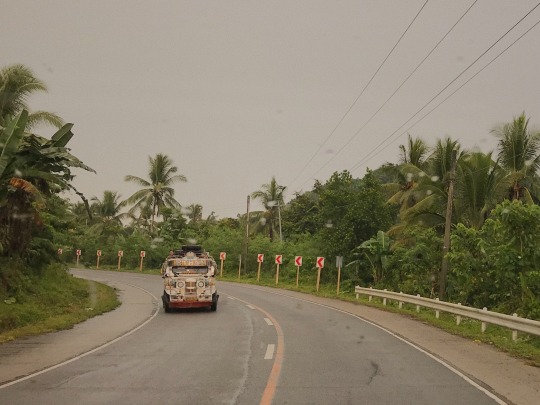
Western Samar, 2018
I traveled to Samar for a 5-day vacation with my two Waray Balikbayan aunties. What they spoke of 60% of the time, I have no clue! Upon landing at Tacloban, we immediately embarked on a 5-hour drive from the airport to my grandmother’s humble home. I’m all groggy and tired, but I can’t waste those 5 hours of stories and beautiful scenery by sleeping.
My aunts hired a local driver and they exchanged short anecdotes on the life of Yolanda survivors after the great Typhoon, the freshness of seafood and vegetables in Samar, the perfect places to buy pasalubongs, etc. I struggle to keep myself in the conversation, asking them to translate in Tagalog a sentence or two.

San Juanico Bridge, 2018
The ride started from souvenir shops, gasoline stations, and small parks, to tall palm trees, an overlooking of the shore, and of course, the Samar-Leyte connection—San Juanico Bridge—and its good-looking view. Serene and beautiful. Not until we noticed the recurring view of identical half-made houses that seemed to be under construction AND abandoned. They were the pabahay (housing) for the victims of Typhoon Yolanda.
Our local driver narrated the current situation of the pabahays. It is a worry that most of the houses can comfortably accommodate only at most 3 people. But, it is even more problematic that most of them currently accommodate less than they can—none—because they are not even halfway done. See, Typhoon Yolanda happened almost 5 years ago.
On a positive note, it is a relief to know that there are housings of good quality provided mostly by the NGOs and other donors. They are medium-sized, beautifully-painted, and some are even equipped with a satellite dish. :)
SAN PEDRO
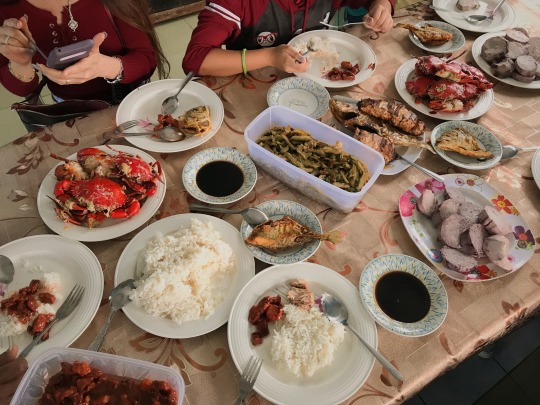
San Pedro, Quinapondan, Eastern Samar, 2018
My grandmother and Aunt Baby, the sweetest of them all, welcomed us with a big hug and a feast of seafood, vegetables, root crops, and meat. Freshness beyond words. We ate together with our hands, and called to meal whosoever happens to pass by the dining area. It was a feast! I can still remember how my hungry, jet-lagged self devoured that meal. Jollibee is no match. Sobrang sarap talaga huhu
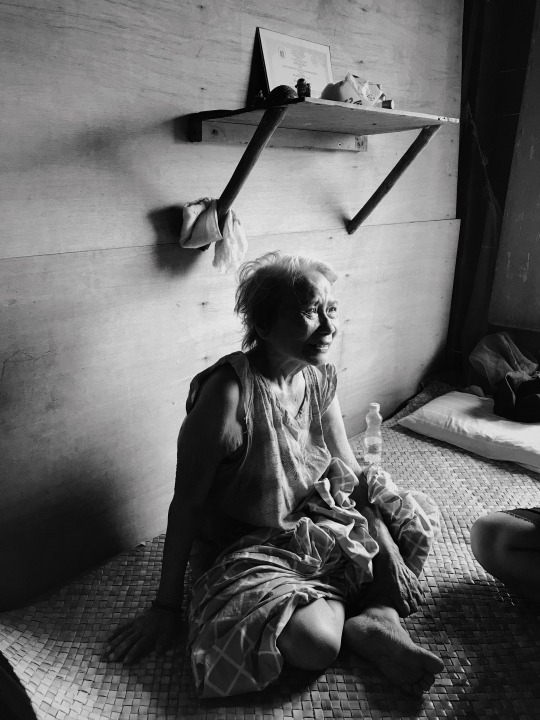
San Pedro, Quinapondan, Eastern Samar, 2018
A mini "welcome tour" from my Aunt Baby followed afterward. Meeting my cousins that day was like meeting them for the first time. We were kids when we last spent time together. My cousins smiled shyly and said nothing as my Aunt Baby called them from their rooms. If their eldest sister--who was of my age--was there, it might have been different.
My Aunt Baby's eldest son tagged along as she led me to the shabby stairs of a bahay kubo across my grandmother's house. The bahay kubo was old and fully furnished, but spacious. It housed relatives I've never met until then: my father’s cousins, their children, and their blind mother—one of my grandmothers. All narrated childhood stories of them and my dad’s. Happy stories, until they get to the part where my daddy left.
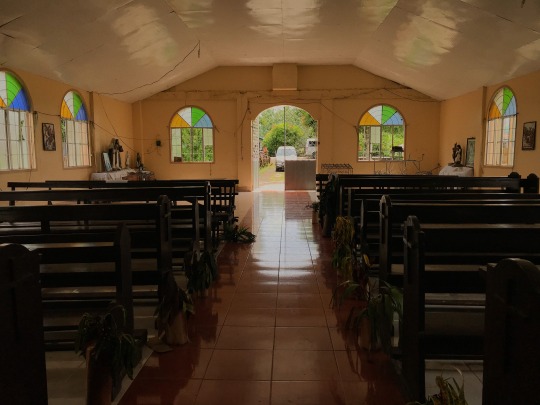
San Pedro Church, Quinapondan, Eastern Samar, 2018

San Pedro Church, Quinapondan, Eastern Samar, 2018 | Fujicolor C200 in Canon TLb
From afar, San Pedro Church looked like a typical province church. Beautiful and small. Up close, it was of dried flowers, broken pews, shattered glass panes, and severed holy statues. I wonder how a church, that stands in the middle of a Barangay, filled with (probably) very religious people, can look so neglected.
We said our prayers, and left.
CALICOAN ISLAND

Calicoan Island, Guiuan, Eastern Samar, 2018 | Fujicolor C200 in Canon TLb
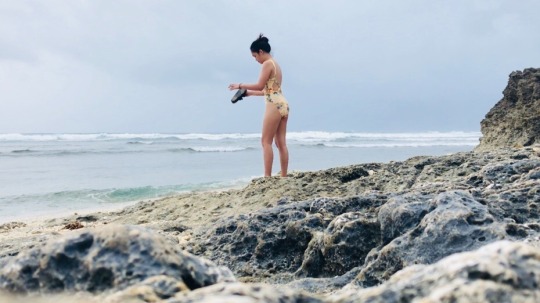
Calicoan Island, Guiuan, Eastern Samar, 2018

Calicoan Island, Guiuan, Eastern Samar, 2018
The moment we arrived, it was low tide. Nevertheless, the Island was beautiful. For someone as easily fascinated as myself, I am in awe. (as usual) I don't have much to say about Calicoan, except that it makes me feel like leaving the City life for good.
Traveling with people who are from a different generation means I have to do my millennial shit alone. And so, that day, as my elders are chitchatting and trying to avoid the sun and the sea, I put on my bathing suit, went down the beach, set up my phone camera beneath the rocks, and took videos and photos of myself along the shore.
Sounds lonely, but it was refreshing.
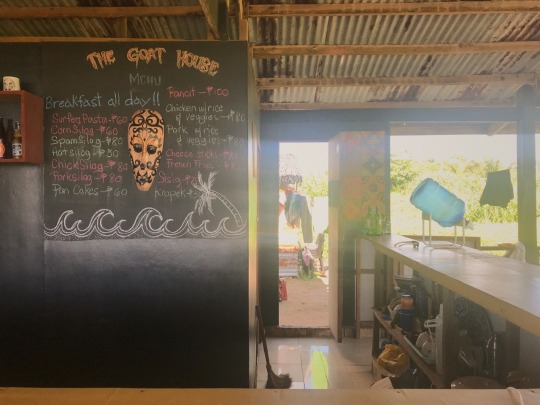
The Goat House, Calicoan Island, Guiuan, Eastern Samar, 2018
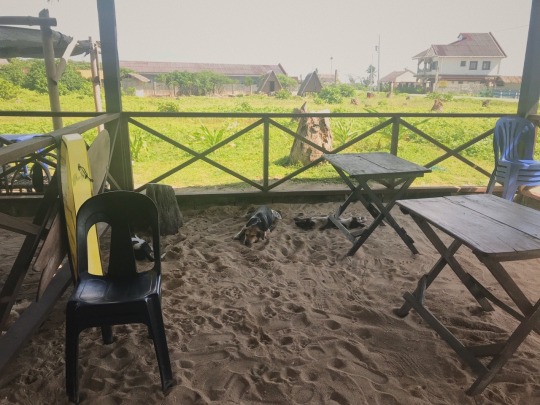
The Goat House, Calicoan Island, Guiuan, Eastern Samar, 2018

The Goat House, Calicoan Island, Guiuan, Eastern Samar, 2018
A few steps away from Calicoan Resort is a surfing spot called ABCD Beach, and across that beach is a small eating place for surfers called The Goat House. I urged my Aunt to try their food, which I had high hopes for. Not as good as I hoped, but the stories we heard inside The Goat House made up for it.
The eatery was manned by 2 locals and a French traveler, the girlfriend of one of the locals. The 32-year-old French waitress served our food, along with the story of the surfing scar on her leg--upon asking. Her travel story followed right after. She was really brave.
Another foreign traveler sits by the wooden bar. The Dutch surfer/customer enthusiastically answered my Aunt's inquiry: "So how's the Philippines?" with very lovely, positive words. It’s a shame that they might’ve experienced the Philippines more than I do. Before leaving, we finished a kakanin that one of my uncles ordered from a vendor by the road. Despite the food, I have no regrets about visiting the place.
SULANGAN
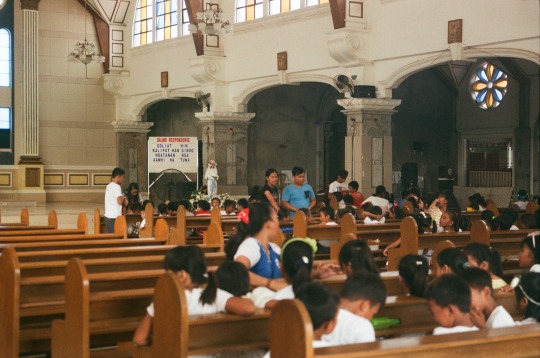
St. Anthony of Padua Parish, Sulangan, Guiuan, Eastern Samar, 2018 | Fujicolor C200 in Canon TLb

St. Anthony of Padua Parish, Sulangan, Guiuan, Eastern Samar, 2018 | Fujicolor C200 in Canon TLb
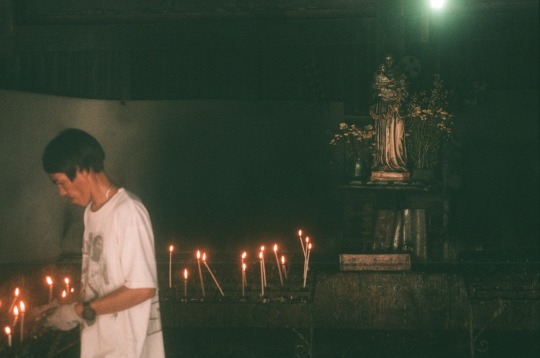
St. Anthony of Padua Parish, Sulangan, Guiuan, Eastern Samar, 2018 | Fujicolor C200 in Canon TLb
This is a corner dedicated for offering prayers to St. Anthony of Padua. As expected, it was filled with Catholic tourists lighting their candles. I waited long for the area to clear up to get a shot. However, as I finally take the long-awaited shot, a man in short bobs and worn-out gloves replaced the group of praying people. He was patiently clearing out the candle drops and leftover wax before another set light new ones. I gladly included him in the frame. Only to find out weeks later that my shot was out of focus. Even so, I enjoyed the people-watching.
SAN PEDRO, AGAIN

San Pedro, Quinapondan, Eastern Samar, 2018
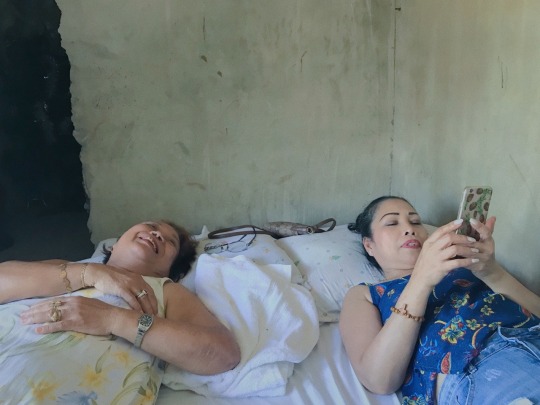
San Pedro, Quinapondan, Eastern Samar, 2018

San Pedro, Quinapondan, Eastern Samar, 2018
It was a mini recap of my dad’s childhood, before finally leaving Samar. I saw the house and the woman--his aunt--who raised my dad. They told me lots of stories, and were very warm. I love old stories by old people.
While my dad was on video call, I looked around the house for the paintings that he was bragging about ever since I landed. This has to be the highlight of my trip--nothing’s more interesting, so far, than my father’s long lost art! Finding nothing, I inquired once again:
“Nasaan na raw po ‘yung mga paintings ni daddy?”
(Where are my daddy’s paintings?)
I got my answer.
“Wala na, natangay ng Yolanda.”
(None are left, they are taken away by (Typhoon) Yolanda.)
For a while there, I was devastated. I could sense my dad was too. So, I let him talk to his old friends and family. He was laughing the whole time, despite the weak signal, pixelated faces, and slurry words.
At that moment, I decided I should go back soon. I’ll be with dad. He will be coming home, too.
--‘Till next time!
3 notes
·
View notes
Photo
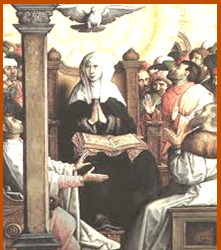
Novenas - Explained
… According to Scripture, after Jesus’ Ascension into heaven, he told his disciples to pray together in the upper room and devote themselves to constant prayer (acts 1: 14). Doctrine proposes that the Apostles, Blessed Virgin Mary, and other followers of Jesus prayed together for Nine consecutive days, concluding in the Descent of the Holy Spirit on Pentecost… *(excerpted from: en.wikipedia.org)
***
Its name deriving from the Latin word "novem," meaning "nine," a novena is nine days’ of private or public devotion in the Catholic Church in order to obtain special graces. Though they are not part of our liturgy they remain as "popular devotions." Novenas have been prayed since the very beginning of the Church - - and even before its official beginning: Mary and the Apostles prayed from Our Lord’s Ascension to Pentecost, a period of nine days (Acts 1). A nine-day period of supplication was also a pagan Roman and Eastern practice, so novenas were easily accepted by the earliest converts in these lands.
The Christian and Jewish meaning of the number "9" also entered into Christian thinking on this matter. The number "9" was associated with suffering, grief, and imperfection, this is a fitting number for when "man’s imperfections turned in prayer to God" (Catholic Encyclopedia). St. Jerome wrote that "the number nine in Holy Writ is indicative of suffering and grief " (Ezechiel, vii, 24).
Novenas, often, but not necessarily, have about them a sense of "urgency"; they are typically made for a special intention, one’s own or another’s (" I’ll make a novena for you"). Novenas to certain Saints are often made according to that Saint’s patronage. For example, because of his New Testament letter encouraging Christians to persevere in the face of persecution, St. Jude is the patron of desperate situations and "hopeless" causes. A person who finds himself or a loved one in a difficult situation might make a novena to St. Jude. After making a novena to St, Jude, it is traditional to make a public expression of your gratitude. This is the reason for those mysterious thank you notes to St. Jude that you might see in your local newspaper’s classified section.
There are four main types of novenas (a novena may fit into more than one category):
Novenas of mourning, such as the novena during the novemdiales-the nine day period following the death of a Pope
Novenas of preparation, or "anticipation," such as the Christmas or Easter Novenas
Novenas of prayer
The indulgenced novenas
When a novena is prayed in anticipation of a Feast, it is typically begun so that it ends the day before the Feast. In order to know when to start a Novena, in anticipation of a Feast, count 10 days back from the Feast, with the Feast itself counting as "one."
Any Novena instructions that include words such as, "say this prayer for 9 consecutive days and your wish will be granted to you," or that describe the Novena as "never fail" in some sense that would lead one to believe that we have God at our beck and call rather than our being His humble servants- well, while the prayers themselves might (or might not) be OK, such instructions should be absolutely rejected.
TO ANSWER A FEW MOST COMMONLY ASKED QUESTIONS
WHAT IS A NOVENA?
A Novena is the reciting of powerful prayers and devotions for a special request over nine consecutive days. Traditionally, a novena included praying, fasting, and meditating.
HOW OFTEN AND FOR HOW LONG SHOULD THE NOVENA BE SAID?
Traditionally, the novena prayer is said for nine days. The nine days signifies the 9 days the early Apostles prayed together during the time between the Ascension of Jesus, and Pentecost, when they experienced the powerful presence of the Holy Spirit. However, there is no hard and fast "rule" for praying; it is best if you adopt a series of prayers and a rhythm for saying them that is comfortable for you and allows you to open a dialogue with God.
What prayers should I say? How do I say them?
Your goal when praying is to focus your heart, mind, and body on communicating with the particular saint for whom you are requesting to intercede on your behalf, during this novena. Praying is best done alone and in a quiet environment. Start by closing your eyes, then describe your special need, and make a heartfelt request for (the saint) to intercede on your behalf to help it to be realized. Your prayer can be as simple as "St. Jude, please help me with (insert your request)", or if you prefer, choose one from a pamphlet of Novena prayers for a particular saint. After saying your particular novena prayers, you should conclude by saying 3 Our Fathers, 3 Hail Mary, and 3 Gloria prayers. Although not required, many people also find that meditating and/or some type of fasting during the nine days provide extra comfort and strength when saying the novena prayers.
WHAT SHOULD I EXPECT TO HAPPEN?
A novena to St. Jude has never been known to fail for those who maintain a strong posture of faith that God is ALWAYS working behind the scenes for us. For some people, by the end of the 9 days, they will see some visible, concrete proof that their request has been granted. For others, they may receive something that is not what they asked for, but turns out to be what they REALLY needed at this point in their lives. And for others, they may experience a newly-found feeling of hope and peace of spirit, that brings with it the sense that they ARE NOT GOING THROUGH THEIR DIFFICULTY ALONE. The beautiful power of the St. Jude novena is that people can have their requests answered in ways or times they may not have expected. The important thing is to believe that you WILL experience a change, and don’t despair if you do not receive an instant answer. Often the path to finding true healing of mind, body, or spirit is a process that will only be fully visible and appreciated after an extended period of time. Praying to St. Jude or any of themany saints is the first step in that process.
There are many novenas available. To mention a few:
NOVENAS TO : THE SACRED HEART OF JESUS, THE PRECIOUS BLOOD, THE HOLY FACE, THE HOLY NAME, THE INFANT OF PRAGUE, CHRIST THE KING, DIVINE MERCY, ST. FRANCIS OF ASSISI, ST. ANTHONY OF PADUA, ST. THERESE OF LISIEUX, ST. PIO OF PIETRELCINA (PADRE PIO), ST. RITA OF CASCIA, ST. PHILOMENA, ST. DYMPHNA, ST. ANNE, ST. JOSEPH, THE ANNUNCIATION, ST. PATRICK, ST. BENEDICT: THERE ARE JUST TO MANY TO MENTION IN THIS PAMPHLET…
***
What Is A Novena Pamphlet
https://docs.wixstatic.com/ugd/a84285_2aa586249d6541c8ab959ba686032c69.pdf
All Novenas
https://www.pamphletstoinspire.com/novenas
5 notes
·
View notes
Photo
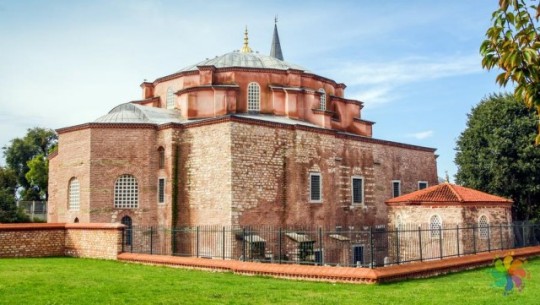
Istanbul Churches
Istanbul met Christianity in the 4th century, while, Paganism was dominant before.
The first Christian churches are Havariyyun, Haghia Sophia and Haghia Eirene. Many churches had been built until the conquest of Istanbul. There the churches of different sects and religious orders such as Nestorianism, Monophysism, Catholicism, Orthodoxy, Syrian Christianity, Gregorianism, Keldani, Dominicanism, Franciscanism has been in Istanbul. Moreover, different nations such as Greek, Armenian, Latin and Genoese also has had their own churches.
The Armenian Patriarchate
The Armenian Patriarchate in Istanbul is one of the four hierarchical centers of the Armenian Church -the others are in Erivan, Beirut and Jerusalem. The first patriarch of Istanbul, Hovaghim I, was in charge during the reign of Fatih Sultan Mehmet. Since r64i, the Virgin Mary (Meryem Ana) Central Church and the traditional wooden Patriarchate building of Istanbul Armenian Patriarchate is in Kumkapi, a harbor once called Konstancalion. Patriarchate complex (Kulliye) is twenty minutes away from Haghia Sophia, the Blue (Sultan Ahmet) Mosque and the Topkapi Palace on foot.
In 2003, all of the Istanbul Armenians will celebrate the 542*h anniversary of the foundation of the Armenian Patriarchate.
St. Anthony of Padua Catholic Church
The architect of St.Anthony Church, at Istiklal Caddesi in Pera (Beyoglu) is Cluilio Mongeri. The construction of the church that lasted six years, was completed in 1912. St. Anthony is not only one of the biggest churches in Istanbul, but also has the largest Catholic community.
The church, in a large court, is a good example of Italian neo-Gothic architecture in red brick.
St. George Fener Greek Orthodox Patriarchate Church
The Greek Orthodox Patriarchate is also in the court of the church in Fener. The Patriarchate moved to St. George (Aya Yorgi) in 1602 that was formerly a monastery. Despite of the church was severely damaged in the fire in 1941 and several other damages occurred in time, it was restorated all the time. The last restoration finished in 1991. St. George is famous with the priceless objects it houses.
The patriarchate throne believed to be from the 5th century, three mosaic icons that there are very little similar examples in the world, a column believed to be the one Jesus Christ had been fastened to and whipped, the coffins of the three saints are some of these objects.
There are few churches in Istanbul with this this type of domes. The Bell tower, built at the entrance is in classical Armenian church architecture style. The interior of the church is ornamented with tiles remained from the church that had collapsed. There are few pictures used for decoration in the church. The interior illumination is through very few and narrow windows, in accordance with Armenian church style.
Aya Istefanos
Aya Istefanos Church, also named “Bulgarian Church”, is located at Mursel Pasa Street by the shore of Golden Horn and completely made of iron casting including the columns ana mezzanine floors in it… The irons were cast in Vienna in 1871 and sent to Golden Horn via sea. The construction has a mobile quality, in other words it can be dismantled and mantled again. It can be moved to and assembled at somewhere else in case needed. The church was made by Aznavour, the famous architect of the age. The church is built for the Bulgarian minority that left Fener Greek Patriarchate, which is located on the hills of Balat. The church is still used by this community, Istanbul churches.
The tombs of the first Bulgarian patriarchs are in the garden. The church attracts the visitors with its splendor in a green and pretty garden at the shore of Golden Horn.
Sakizagaci Surp Asdvazazin Cathedral
The Armenian Church in Besiktas, Sakizagaci was built in 1866. Apart from the main altar ornamented with four columns, devoted to Virgin Mary; there are four other altars decorated with the paintings by the Roman artists. Although the annexes were seriously damaged during the fire of Perain 1870, the main church building was saved with little damage.
Ortakoy Surp Kirkor Lusavorig Church
The Armenian Catholic Church built between 1837-1838 costed 5961 golden liras then. Although partially, the architecture of the church resembles the Roman basilicas. The church has a central section and two corridors.
The fairly decorative ceilings rise over eight columns in the middle section. There is a painting on the main altar, depicting Surp (Saint) Kirkor Lusaroviq baptizi Dirtat U the king of Armenia. There are four more altars in the church.
St. Pierre Church
The Dominican priests had to move to this place down the Galata Tower owing to the fact that their original church (Arap Cami) was converted to mosque. The current building, remaining from 1841, was made by the F’ossati brothers, the Italian-Swedish originated architects who also worked for the restoration of Haghia Sophia .The rear walls of the church were built in some parts of the old Genoese city walls. There used to be a Maltese minority among the mixed people of Istanbul until recently and this church was mostly serving to them. The most important property of the building is the icon of Hodegetria (The Guiding Virgin Mary), the protector of Byzantium in a silver bowl. Behind the church are a beautiful annexed and a monastery, again in Italian style. Two more towers of the Genoese wall can be seen in the street behind the church.
A court should be passed in order to get into the church, because the front side of a building never faced the street in Ottoman order. You must ring the bell to get in.
The church was built in basilica style with its four sided altar. The sky blue dome above the chorus stage was decorated with golden gildings.
Haghia Eirene Church
“The Church of Holy Peace” is in the first court of the Topkapi Palace. It was built in the 4^ century and the oldest church in the city. It took its current form in 740 and used for storing arms and munitions during the Ottoman Empire. It has been used for exhibitions and cultural activities after the restoration.
The God Zeus, transforms his lover Io into a cow in order to avoid his wife Hera’s anger. However Hera sends a gadfly to bother this cow and Io runs from one continent to another, however cannot get rid of the gadfly, finally she jumps into the sea on a shore and swims to Asia, thus gives her name to a sea and a strait: The Bosporus, or The Ford of the Cow. It is hard to imagine while looking at its deep blue waters today that once it was the topic of a great disagreement.
The Troyan War was a war that began for the city of Troy and Argonauts that were in the quest for the Golden Fleece, had been the first human beings that passed the Bosporus. The deepest point of the Bosporus is 20m and is 33 km long; it is 660m at its narrowest while 4.7km at its widest. The predominant surface current flows from the Black Sea to the Marmara, while the main current moves towards the reverse direction.
Source: https://www.doholidays.com/istanbul-churches/
0 notes
Photo
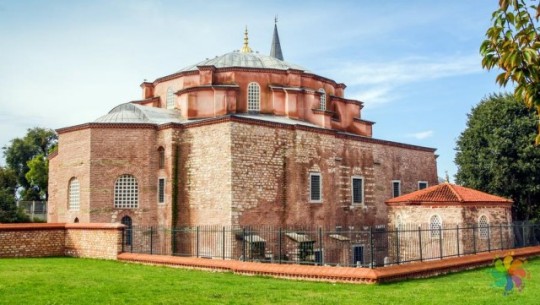
Istanbul Churches
Istanbul met Christianity in the 4th century, while, Paganism was dominant before.
The first Christian churches are Havariyyun, Haghia Sophia and Haghia Eirene. Many churches had been built until the conquest of Istanbul. There the churches of different sects and religious orders such as Nestorianism, Monophysism, Catholicism, Orthodoxy, Syrian Christianity, Gregorianism, Keldani, Dominicanism, Franciscanism has been in Istanbul. Moreover, different nations such as Greek, Armenian, Latin and Genoese also has had their own churches.
The Armenian Patriarchate
The Armenian Patriarchate in Istanbul is one of the four hierarchical centers of the Armenian Church -the others are in Erivan, Beirut and Jerusalem. The first patriarch of Istanbul, Hovaghim I, was in charge during the reign of Fatih Sultan Mehmet. Since r64i, the Virgin Mary (Meryem Ana) Central Church and the traditional wooden Patriarchate building of Istanbul Armenian Patriarchate is in Kumkapi, a harbor once called Konstancalion. Patriarchate complex (Kulliye) is twenty minutes away from Haghia Sophia, the Blue (Sultan Ahmet) Mosque and the Topkapi Palace on foot.
In 2003, all of the Istanbul Armenians will celebrate the 542*h anniversary of the foundation of the Armenian Patriarchate.
St. Anthony of Padua Catholic Church
The architect of St.Anthony Church, at Istiklal Caddesi in Pera (Beyoglu) is Cluilio Mongeri. The construction of the church that lasted six years, was completed in 1912. St. Anthony is not only one of the biggest churches in Istanbul, but also has the largest Catholic community.
The church, in a large court, is a good example of Italian neo-Gothic architecture in red brick.
St. George Fener Greek Orthodox Patriarchate Church
The Greek Orthodox Patriarchate is also in the court of the church in Fener. The Patriarchate moved to St. George (Aya Yorgi) in 1602 that was formerly a monastery. Despite of the church was severely damaged in the fire in 1941 and several other damages occurred in time, it was restorated all the time. The last restoration finished in 1991. St. George is famous with the priceless objects it houses.
The patriarchate throne believed to be from the 5th century, three mosaic icons that there are very little similar examples in the world, a column believed to be the one Jesus Christ had been fastened to and whipped, the coffins of the three saints are some of these objects.
There are few churches in Istanbul with this this type of domes. The Bell tower, built at the entrance is in classical Armenian church architecture style. The interior of the church is ornamented with tiles remained from the church that had collapsed. There are few pictures used for decoration in the church. The interior illumination is through very few and narrow windows, in accordance with Armenian church style.
Aya Istefanos
Aya Istefanos Church, also named “Bulgarian Church”, is located at Mursel Pasa Street by the shore of Golden Horn and completely made of iron casting including the columns ana mezzanine floors in it… The irons were cast in Vienna in 1871 and sent to Golden Horn via sea. The construction has a mobile quality, in other words it can be dismantled and mantled again. It can be moved to and assembled at somewhere else in case needed. The church was made by Aznavour, the famous architect of the age. The church is built for the Bulgarian minority that left Fener Greek Patriarchate, which is located on the hills of Balat. The church is still used by this community, Istanbul churches.
The tombs of the first Bulgarian patriarchs are in the garden. The church attracts the visitors with its splendor in a green and pretty garden at the shore of Golden Horn.
Sakizagaci Surp Asdvazazin Cathedral
The Armenian Church in Besiktas, Sakizagaci was built in 1866. Apart from the main altar ornamented with four columns, devoted to Virgin Mary; there are four other altars decorated with the paintings by the Roman artists. Although the annexes were seriously damaged during the fire of Perain 1870, the main church building was saved with little damage.
Ortakoy Surp Kirkor Lusavorig Church
The Armenian Catholic Church built between 1837-1838 costed 5961 golden liras then. Although partially, the architecture of the church resembles the Roman basilicas. The church has a central section and two corridors.
The fairly decorative ceilings rise over eight columns in the middle section. There is a painting on the main altar, depicting Surp (Saint) Kirkor Lusaroviq baptizi Dirtat U the king of Armenia. There are four more altars in the church.
St. Pierre Church
The Dominican priests had to move to this place down the Galata Tower owing to the fact that their original church (Arap Cami) was converted to mosque. The current building, remaining from 1841, was made by the F’ossati brothers, the Italian-Swedish originated architects who also worked for the restoration of Haghia Sophia .The rear walls of the church were built in some parts of the old Genoese city walls. There used to be a Maltese minority among the mixed people of Istanbul until recently and this church was mostly serving to them. The most important property of the building is the icon of Hodegetria (The Guiding Virgin Mary), the protector of Byzantium in a silver bowl. Behind the church are a beautiful annexed and a monastery, again in Italian style. Two more towers of the Genoese wall can be seen in the street behind the church.
A court should be passed in order to get into the church, because the front side of a building never faced the street in Ottoman order. You must ring the bell to get in.
The church was built in basilica style with its four sided altar. The sky blue dome above the chorus stage was decorated with golden gildings.
Haghia Eirene Church
“The Church of Holy Peace” is in the first court of the Topkapi Palace. It was built in the 4^ century and the oldest church in the city. It took its current form in 740 and used for storing arms and munitions during the Ottoman Empire. It has been used for exhibitions and cultural activities after the restoration.
The God Zeus, transforms his lover Io into a cow in order to avoid his wife Hera’s anger. However Hera sends a gadfly to bother this cow and Io runs from one continent to another, however cannot get rid of the gadfly, finally she jumps into the sea on a shore and swims to Asia, thus gives her name to a sea and a strait: The Bosporus, or The Ford of the Cow. It is hard to imagine while looking at its deep blue waters today that once it was the topic of a great disagreement.
The Troyan War was a war that began for the city of Troy and Argonauts that were in the quest for the Golden Fleece, had been the first human beings that passed the Bosporus. The deepest point of the Bosporus is 20m and is 33 km long; it is 660m at its narrowest while 4.7km at its widest. The predominant surface current flows from the Black Sea to the Marmara, while the main current moves towards the reverse direction.
Source: https://www.doholidays.com/istanbul-churches/
0 notes
Photo

Istanbul Churches
Istanbul met Christianity in the 4th century, while, Paganism was dominant before.
The first Christian churches are Havariyyun, Haghia Sophia and Haghia Eirene. Many churches had been built until the conquest of Istanbul. There the churches of different sects and religious orders such as Nestorianism, Monophysism, Catholicism, Orthodoxy, Syrian Christianity, Gregorianism, Keldani, Dominicanism, Franciscanism has been in Istanbul. Moreover, different nations such as Greek, Armenian, Latin and Genoese also has had their own churches.
The Armenian Patriarchate
The Armenian Patriarchate in Istanbul is one of the four hierarchical centers of the Armenian Church -the others are in Erivan, Beirut and Jerusalem. The first patriarch of Istanbul, Hovaghim I, was in charge during the reign of Fatih Sultan Mehmet. Since r64i, the Virgin Mary (Meryem Ana) Central Church and the traditional wooden Patriarchate building of Istanbul Armenian Patriarchate is in Kumkapi, a harbor once called Konstancalion. Patriarchate complex (Kulliye) is twenty minutes away from Haghia Sophia, the Blue (Sultan Ahmet) Mosque and the Topkapi Palace on foot.
In 2003, all of the Istanbul Armenians will celebrate the 542*h anniversary of the foundation of the Armenian Patriarchate.
St. Anthony of Padua Catholic Church
The architect of St.Anthony Church, at Istiklal Caddesi in Pera (Beyoglu) is Cluilio Mongeri. The construction of the church that lasted six years, was completed in 1912. St. Anthony is not only one of the biggest churches in Istanbul, but also has the largest Catholic community.
The church, in a large court, is a good example of Italian neo-Gothic architecture in red brick.
St. George Fener Greek Orthodox Patriarchate Church
The Greek Orthodox Patriarchate is also in the court of the church in Fener. The Patriarchate moved to St. George (Aya Yorgi) in 1602 that was formerly a monastery. Despite of the church was severely damaged in the fire in 1941 and several other damages occurred in time, it was restorated all the time. The last restoration finished in 1991. St. George is famous with the priceless objects it houses.
The patriarchate throne believed to be from the 5th century, three mosaic icons that there are very little similar examples in the world, a column believed to be the one Jesus Christ had been fastened to and whipped, the coffins of the three saints are some of these objects.
There are few churches in Istanbul with this this type of domes. The Bell tower, built at the entrance is in classical Armenian church architecture style. The interior of the church is ornamented with tiles remained from the church that had collapsed. There are few pictures used for decoration in the church. The interior illumination is through very few and narrow windows, in accordance with Armenian church style.
Aya Istefanos
Aya Istefanos Church, also named “Bulgarian Church”, is located at Mursel Pasa Street by the shore of Golden Horn and completely made of iron casting including the columns ana mezzanine floors in it… The irons were cast in Vienna in 1871 and sent to Golden Horn via sea. The construction has a mobile quality, in other words it can be dismantled and mantled again. It can be moved to and assembled at somewhere else in case needed. The church was made by Aznavour, the famous architect of the age. The church is built for the Bulgarian minority that left Fener Greek Patriarchate, which is located on the hills of Balat. The church is still used by this community, Istanbul churches.
The tombs of the first Bulgarian patriarchs are in the garden. The church attracts the visitors with its splendor in a green and pretty garden at the shore of Golden Horn.
Sakizagaci Surp Asdvazazin Cathedral
The Armenian Church in Besiktas, Sakizagaci was built in 1866. Apart from the main altar ornamented with four columns, devoted to Virgin Mary; there are four other altars decorated with the paintings by the Roman artists. Although the annexes were seriously damaged during the fire of Perain 1870, the main church building was saved with little damage.
Ortakoy Surp Kirkor Lusavorig Church
The Armenian Catholic Church built between 1837-1838 costed 5961 golden liras then. Although partially, the architecture of the church resembles the Roman basilicas. The church has a central section and two corridors.
The fairly decorative ceilings rise over eight columns in the middle section. There is a painting on the main altar, depicting Surp (Saint) Kirkor Lusaroviq baptizi Dirtat U the king of Armenia. There are four more altars in the church.
St. Pierre Church
The Dominican priests had to move to this place down the Galata Tower owing to the fact that their original church (Arap Cami) was converted to mosque. The current building, remaining from 1841, was made by the F’ossati brothers, the Italian-Swedish originated architects who also worked for the restoration of Haghia Sophia .The rear walls of the church were built in some parts of the old Genoese city walls. There used to be a Maltese minority among the mixed people of Istanbul until recently and this church was mostly serving to them. The most important property of the building is the icon of Hodegetria (The Guiding Virgin Mary), the protector of Byzantium in a silver bowl. Behind the church are a beautiful annexed and a monastery, again in Italian style. Two more towers of the Genoese wall can be seen in the street behind the church.
A court should be passed in order to get into the church, because the front side of a building never faced the street in Ottoman order. You must ring the bell to get in.
The church was built in basilica style with its four sided altar. The sky blue dome above the chorus stage was decorated with golden gildings.
Haghia Eirene Church
“The Church of Holy Peace” is in the first court of the Topkapi Palace. It was built in the 4^ century and the oldest church in the city. It took its current form in 740 and used for storing arms and munitions during the Ottoman Empire. It has been used for exhibitions and cultural activities after the restoration.
The God Zeus, transforms his lover Io into a cow in order to avoid his wife Hera’s anger. However Hera sends a gadfly to bother this cow and Io runs from one continent to another, however cannot get rid of the gadfly, finally she jumps into the sea on a shore and swims to Asia, thus gives her name to a sea and a strait: The Bosporus, or The Ford of the Cow. It is hard to imagine while looking at its deep blue waters today that once it was the topic of a great disagreement.
The Troyan War was a war that began for the city of Troy and Argonauts that were in the quest for the Golden Fleece, had been the first human beings that passed the Bosporus. The deepest point of the Bosporus is 20m and is 33 km long; it is 660m at its narrowest while 4.7km at its widest. The predominant surface current flows from the Black Sea to the Marmara, while the main current moves towards the reverse direction.
Source: https://www.doholidays.com/istanbul-churches/
0 notes
Photo
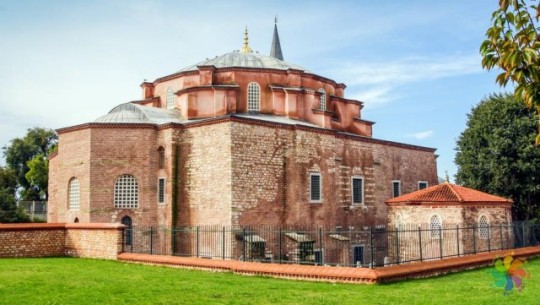
Istanbul Churches
Istanbul met Christianity in the 4th century, while, Paganism was dominant before.
The first Christian churches are Havariyyun, Haghia Sophia and Haghia Eirene. Many churches had been built until the conquest of Istanbul. There the churches of different sects and religious orders such as Nestorianism, Monophysism, Catholicism, Orthodoxy, Syrian Christianity, Gregorianism, Keldani, Dominicanism, Franciscanism has been in Istanbul. Moreover, different nations such as Greek, Armenian, Latin and Genoese also has had their own churches.
The Armenian Patriarchate
The Armenian Patriarchate in Istanbul is one of the four hierarchical centers of the Armenian Church -the others are in Erivan, Beirut and Jerusalem. The first patriarch of Istanbul, Hovaghim I, was in charge during the reign of Fatih Sultan Mehmet. Since r64i, the Virgin Mary (Meryem Ana) Central Church and the traditional wooden Patriarchate building of Istanbul Armenian Patriarchate is in Kumkapi, a harbor once called Konstancalion. Patriarchate complex (Kulliye) is twenty minutes away from Haghia Sophia, the Blue (Sultan Ahmet) Mosque and the Topkapi Palace on foot.
In 2003, all of the Istanbul Armenians will celebrate the 542*h anniversary of the foundation of the Armenian Patriarchate.
St. Anthony of Padua Catholic Church
The architect of St.Anthony Church, at Istiklal Caddesi in Pera (Beyoglu) is Cluilio Mongeri. The construction of the church that lasted six years, was completed in 1912. St. Anthony is not only one of the biggest churches in Istanbul, but also has the largest Catholic community.
The church, in a large court, is a good example of Italian neo-Gothic architecture in red brick.
St. George Fener Greek Orthodox Patriarchate Church
The Greek Orthodox Patriarchate is also in the court of the church in Fener. The Patriarchate moved to St. George (Aya Yorgi) in 1602 that was formerly a monastery. Despite of the church was severely damaged in the fire in 1941 and several other damages occurred in time, it was restorated all the time. The last restoration finished in 1991. St. George is famous with the priceless objects it houses.
The patriarchate throne believed to be from the 5th century, three mosaic icons that there are very little similar examples in the world, a column believed to be the one Jesus Christ had been fastened to and whipped, the coffins of the three saints are some of these objects.
There are few churches in Istanbul with this this type of domes. The Bell tower, built at the entrance is in classical Armenian church architecture style. The interior of the church is ornamented with tiles remained from the church that had collapsed. There are few pictures used for decoration in the church. The interior illumination is through very few and narrow windows, in accordance with Armenian church style.
Aya Istefanos
Aya Istefanos Church, also named “Bulgarian Church”, is located at Mursel Pasa Street by the shore of Golden Horn and completely made of iron casting including the columns ana mezzanine floors in it… The irons were cast in Vienna in 1871 and sent to Golden Horn via sea. The construction has a mobile quality, in other words it can be dismantled and mantled again. It can be moved to and assembled at somewhere else in case needed. The church was made by Aznavour, the famous architect of the age. The church is built for the Bulgarian minority that left Fener Greek Patriarchate, which is located on the hills of Balat. The church is still used by this community, Istanbul churches.
The tombs of the first Bulgarian patriarchs are in the garden. The church attracts the visitors with its splendor in a green and pretty garden at the shore of Golden Horn.
Sakizagaci Surp Asdvazazin Cathedral
The Armenian Church in Besiktas, Sakizagaci was built in 1866. Apart from the main altar ornamented with four columns, devoted to Virgin Mary; there are four other altars decorated with the paintings by the Roman artists. Although the annexes were seriously damaged during the fire of Perain 1870, the main church building was saved with little damage.
Ortakoy Surp Kirkor Lusavorig Church
The Armenian Catholic Church built between 1837-1838 costed 5961 golden liras then. Although partially, the architecture of the church resembles the Roman basilicas. The church has a central section and two corridors.
The fairly decorative ceilings rise over eight columns in the middle section. There is a painting on the main altar, depicting Surp (Saint) Kirkor Lusaroviq baptizi Dirtat U the king of Armenia. There are four more altars in the church.
St. Pierre Church
The Dominican priests had to move to this place down the Galata Tower owing to the fact that their original church (Arap Cami) was converted to mosque. The current building, remaining from 1841, was made by the F’ossati brothers, the Italian-Swedish originated architects who also worked for the restoration of Haghia Sophia .The rear walls of the church were built in some parts of the old Genoese city walls. There used to be a Maltese minority among the mixed people of Istanbul until recently and this church was mostly serving to them. The most important property of the building is the icon of Hodegetria (The Guiding Virgin Mary), the protector of Byzantium in a silver bowl. Behind the church are a beautiful annexed and a monastery, again in Italian style. Two more towers of the Genoese wall can be seen in the street behind the church.
A court should be passed in order to get into the church, because the front side of a building never faced the street in Ottoman order. You must ring the bell to get in.
The church was built in basilica style with its four sided altar. The sky blue dome above the chorus stage was decorated with golden gildings.
Haghia Eirene Church
“The Church of Holy Peace” is in the first court of the Topkapi Palace. It was built in the 4^ century and the oldest church in the city. It took its current form in 740 and used for storing arms and munitions during the Ottoman Empire. It has been used for exhibitions and cultural activities after the restoration.
The God Zeus, transforms his lover Io into a cow in order to avoid his wife Hera’s anger. However Hera sends a gadfly to bother this cow and Io runs from one continent to another, however cannot get rid of the gadfly, finally she jumps into the sea on a shore and swims to Asia, thus gives her name to a sea and a strait: The Bosporus, or The Ford of the Cow. It is hard to imagine while looking at its deep blue waters today that once it was the topic of a great disagreement.
The Troyan War was a war that began for the city of Troy and Argonauts that were in the quest for the Golden Fleece, had been the first human beings that passed the Bosporus. The deepest point of the Bosporus is 20m and is 33 km long; it is 660m at its narrowest while 4.7km at its widest. The predominant surface current flows from the Black Sea to the Marmara, while the main current moves towards the reverse direction.
Source: https://www.doholidays.com/istanbul-churches/
0 notes
Photo
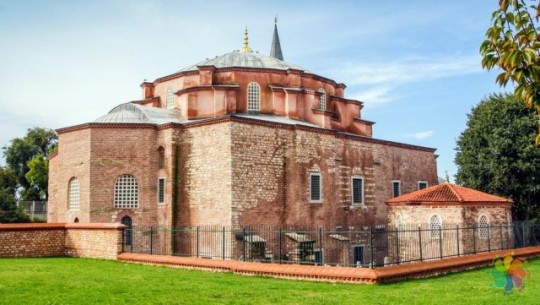
Istanbul Churches
Istanbul met Christianity in the 4th century, while, Paganism was dominant before.
The first Christian churches are Havariyyun, Haghia Sophia and Haghia Eirene. Many churches had been built until the conquest of Istanbul. There the churches of different sects and religious orders such as Nestorianism, Monophysism, Catholicism, Orthodoxy, Syrian Christianity, Gregorianism, Keldani, Dominicanism, Franciscanism has been in Istanbul. Moreover, different nations such as Greek, Armenian, Latin and Genoese also has had their own churches.
The Armenian Patriarchate
The Armenian Patriarchate in Istanbul is one of the four hierarchical centers of the Armenian Church -the others are in Erivan, Beirut and Jerusalem. The first patriarch of Istanbul, Hovaghim I, was in charge during the reign of Fatih Sultan Mehmet. Since r64i, the Virgin Mary (Meryem Ana) Central Church and the traditional wooden Patriarchate building of Istanbul Armenian Patriarchate is in Kumkapi, a harbor once called Konstancalion. Patriarchate complex (Kulliye) is twenty minutes away from Haghia Sophia, the Blue (Sultan Ahmet) Mosque and the Topkapi Palace on foot.
In 2003, all of the Istanbul Armenians will celebrate the 542*h anniversary of the foundation of the Armenian Patriarchate.
St. Anthony of Padua Catholic Church
The architect of St.Anthony Church, at Istiklal Caddesi in Pera (Beyoglu) is Cluilio Mongeri. The construction of the church that lasted six years, was completed in 1912. St. Anthony is not only one of the biggest churches in Istanbul, but also has the largest Catholic community.
The church, in a large court, is a good example of Italian neo-Gothic architecture in red brick.
St. George Fener Greek Orthodox Patriarchate Church
The Greek Orthodox Patriarchate is also in the court of the church in Fener. The Patriarchate moved to St. George (Aya Yorgi) in 1602 that was formerly a monastery. Despite of the church was severely damaged in the fire in 1941 and several other damages occurred in time, it was restorated all the time. The last restoration finished in 1991. St. George is famous with the priceless objects it houses.
The patriarchate throne believed to be from the 5th century, three mosaic icons that there are very little similar examples in the world, a column believed to be the one Jesus Christ had been fastened to and whipped, the coffins of the three saints are some of these objects.
There are few churches in Istanbul with this this type of domes. The Bell tower, built at the entrance is in classical Armenian church architecture style. The interior of the church is ornamented with tiles remained from the church that had collapsed. There are few pictures used for decoration in the church. The interior illumination is through very few and narrow windows, in accordance with Armenian church style.
Aya Istefanos
Aya Istefanos Church, also named “Bulgarian Church”, is located at Mursel Pasa Street by the shore of Golden Horn and completely made of iron casting including the columns ana mezzanine floors in it… The irons were cast in Vienna in 1871 and sent to Golden Horn via sea. The construction has a mobile quality, in other words it can be dismantled and mantled again. It can be moved to and assembled at somewhere else in case needed. The church was made by Aznavour, the famous architect of the age. The church is built for the Bulgarian minority that left Fener Greek Patriarchate, which is located on the hills of Balat. The church is still used by this community, Istanbul churches.
The tombs of the first Bulgarian patriarchs are in the garden. The church attracts the visitors with its splendor in a green and pretty garden at the shore of Golden Horn.
Sakizagaci Surp Asdvazazin Cathedral
The Armenian Church in Besiktas, Sakizagaci was built in 1866. Apart from the main altar ornamented with four columns, devoted to Virgin Mary; there are four other altars decorated with the paintings by the Roman artists. Although the annexes were seriously damaged during the fire of Perain 1870, the main church building was saved with little damage.
Ortakoy Surp Kirkor Lusavorig Church
The Armenian Catholic Church built between 1837-1838 costed 5961 golden liras then. Although partially, the architecture of the church resembles the Roman basilicas. The church has a central section and two corridors.
The fairly decorative ceilings rise over eight columns in the middle section. There is a painting on the main altar, depicting Surp (Saint) Kirkor Lusaroviq baptizi Dirtat U the king of Armenia. There are four more altars in the church.
St. Pierre Church
The Dominican priests had to move to this place down the Galata Tower owing to the fact that their original church (Arap Cami) was converted to mosque. The current building, remaining from 1841, was made by the F’ossati brothers, the Italian-Swedish originated architects who also worked for the restoration of Haghia Sophia .The rear walls of the church were built in some parts of the old Genoese city walls. There used to be a Maltese minority among the mixed people of Istanbul until recently and this church was mostly serving to them. The most important property of the building is the icon of Hodegetria (The Guiding Virgin Mary), the protector of Byzantium in a silver bowl. Behind the church are a beautiful annexed and a monastery, again in Italian style. Two more towers of the Genoese wall can be seen in the street behind the church.
A court should be passed in order to get into the church, because the front side of a building never faced the street in Ottoman order. You must ring the bell to get in.
The church was built in basilica style with its four sided altar. The sky blue dome above the chorus stage was decorated with golden gildings.
Haghia Eirene Church
“The Church of Holy Peace” is in the first court of the Topkapi Palace. It was built in the 4^ century and the oldest church in the city. It took its current form in 740 and used for storing arms and munitions during the Ottoman Empire. It has been used for exhibitions and cultural activities after the restoration.
The God Zeus, transforms his lover Io into a cow in order to avoid his wife Hera’s anger. However Hera sends a gadfly to bother this cow and Io runs from one continent to another, however cannot get rid of the gadfly, finally she jumps into the sea on a shore and swims to Asia, thus gives her name to a sea and a strait: The Bosporus, or The Ford of the Cow. It is hard to imagine while looking at its deep blue waters today that once it was the topic of a great disagreement.
The Troyan War was a war that began for the city of Troy and Argonauts that were in the quest for the Golden Fleece, had been the first human beings that passed the Bosporus. The deepest point of the Bosporus is 20m and is 33 km long; it is 660m at its narrowest while 4.7km at its widest. The predominant surface current flows from the Black Sea to the Marmara, while the main current moves towards the reverse direction.
Source: https://www.doholidays.com/istanbul-churches/
0 notes
Photo

Istanbul Churches
Istanbul met Christianity in the 4th century, while, Paganism was dominant before.
The first Christian churches are Havariyyun, Haghia Sophia and Haghia Eirene. Many churches had been built until the conquest of Istanbul. There the churches of different sects and religious orders such as Nestorianism, Monophysism, Catholicism, Orthodoxy, Syrian Christianity, Gregorianism, Keldani, Dominicanism, Franciscanism has been in Istanbul. Moreover, different nations such as Greek, Armenian, Latin and Genoese also has had their own churches.
The Armenian Patriarchate
The Armenian Patriarchate in Istanbul is one of the four hierarchical centers of the Armenian Church -the others are in Erivan, Beirut and Jerusalem. The first patriarch of Istanbul, Hovaghim I, was in charge during the reign of Fatih Sultan Mehmet. Since r64i, the Virgin Mary (Meryem Ana) Central Church and the traditional wooden Patriarchate building of Istanbul Armenian Patriarchate is in Kumkapi, a harbor once called Konstancalion. Patriarchate complex (Kulliye) is twenty minutes away from Haghia Sophia, the Blue (Sultan Ahmet) Mosque and the Topkapi Palace on foot.
In 2003, all of the Istanbul Armenians will celebrate the 542*h anniversary of the foundation of the Armenian Patriarchate.
St. Anthony of Padua Catholic Church
The architect of St.Anthony Church, at Istiklal Caddesi in Pera (Beyoglu) is Cluilio Mongeri. The construction of the church that lasted six years, was completed in 1912. St. Anthony is not only one of the biggest churches in Istanbul, but also has the largest Catholic community.
The church, in a large court, is a good example of Italian neo-Gothic architecture in red brick.
St. George Fener Greek Orthodox Patriarchate Church
The Greek Orthodox Patriarchate is also in the court of the church in Fener. The Patriarchate moved to St. George (Aya Yorgi) in 1602 that was formerly a monastery. Despite of the church was severely damaged in the fire in 1941 and several other damages occurred in time, it was restorated all the time. The last restoration finished in 1991. St. George is famous with the priceless objects it houses.
The patriarchate throne believed to be from the 5th century, three mosaic icons that there are very little similar examples in the world, a column believed to be the one Jesus Christ had been fastened to and whipped, the coffins of the three saints are some of these objects.
There are few churches in Istanbul with this this type of domes. The Bell tower, built at the entrance is in classical Armenian church architecture style. The interior of the church is ornamented with tiles remained from the church that had collapsed. There are few pictures used for decoration in the church. The interior illumination is through very few and narrow windows, in accordance with Armenian church style.
Aya Istefanos
Aya Istefanos Church, also named “Bulgarian Church”, is located at Mursel Pasa Street by the shore of Golden Horn and completely made of iron casting including the columns ana mezzanine floors in it… The irons were cast in Vienna in 1871 and sent to Golden Horn via sea. The construction has a mobile quality, in other words it can be dismantled and mantled again. It can be moved to and assembled at somewhere else in case needed. The church was made by Aznavour, the famous architect of the age. The church is built for the Bulgarian minority that left Fener Greek Patriarchate, which is located on the hills of Balat. The church is still used by this community, Istanbul churches.
The tombs of the first Bulgarian patriarchs are in the garden. The church attracts the visitors with its splendor in a green and pretty garden at the shore of Golden Horn.
Sakizagaci Surp Asdvazazin Cathedral
The Armenian Church in Besiktas, Sakizagaci was built in 1866. Apart from the main altar ornamented with four columns, devoted to Virgin Mary; there are four other altars decorated with the paintings by the Roman artists. Although the annexes were seriously damaged during the fire of Perain 1870, the main church building was saved with little damage.
Ortakoy Surp Kirkor Lusavorig Church
The Armenian Catholic Church built between 1837-1838 costed 5961 golden liras then. Although partially, the architecture of the church resembles the Roman basilicas. The church has a central section and two corridors.
The fairly decorative ceilings rise over eight columns in the middle section. There is a painting on the main altar, depicting Surp (Saint) Kirkor Lusaroviq baptizi Dirtat U the king of Armenia. There are four more altars in the church.
St. Pierre Church
The Dominican priests had to move to this place down the Galata Tower owing to the fact that their original church (Arap Cami) was converted to mosque. The current building, remaining from 1841, was made by the F’ossati brothers, the Italian-Swedish originated architects who also worked for the restoration of Haghia Sophia .The rear walls of the church were built in some parts of the old Genoese city walls. There used to be a Maltese minority among the mixed people of Istanbul until recently and this church was mostly serving to them. The most important property of the building is the icon of Hodegetria (The Guiding Virgin Mary), the protector of Byzantium in a silver bowl. Behind the church are a beautiful annexed and a monastery, again in Italian style. Two more towers of the Genoese wall can be seen in the street behind the church.
A court should be passed in order to get into the church, because the front side of a building never faced the street in Ottoman order. You must ring the bell to get in.
The church was built in basilica style with its four sided altar. The sky blue dome above the chorus stage was decorated with golden gildings.
Haghia Eirene Church
“The Church of Holy Peace” is in the first court of the Topkapi Palace. It was built in the 4^ century and the oldest church in the city. It took its current form in 740 and used for storing arms and munitions during the Ottoman Empire. It has been used for exhibitions and cultural activities after the restoration.
The God Zeus, transforms his lover Io into a cow in order to avoid his wife Hera’s anger. However Hera sends a gadfly to bother this cow and Io runs from one continent to another, however cannot get rid of the gadfly, finally she jumps into the sea on a shore and swims to Asia, thus gives her name to a sea and a strait: The Bosporus, or The Ford of the Cow. It is hard to imagine while looking at its deep blue waters today that once it was the topic of a great disagreement.
The Troyan War was a war that began for the city of Troy and Argonauts that were in the quest for the Golden Fleece, had been the first human beings that passed the Bosporus. The deepest point of the Bosporus is 20m and is 33 km long; it is 660m at its narrowest while 4.7km at its widest. The predominant surface current flows from the Black Sea to the Marmara, while the main current moves towards the reverse direction.
Source: https://www.doholidays.com/istanbul-churches/
0 notes
Photo
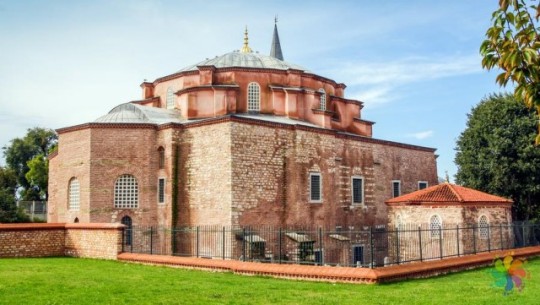
Istanbul Churches
Istanbul met Christianity in the 4th century, while, Paganism was dominant before.
The first Christian churches are Havariyyun, Haghia Sophia and Haghia Eirene. Many churches had been built until the conquest of Istanbul. There the churches of different sects and religious orders such as Nestorianism, Monophysism, Catholicism, Orthodoxy, Syrian Christianity, Gregorianism, Keldani, Dominicanism, Franciscanism has been in Istanbul. Moreover, different nations such as Greek, Armenian, Latin and Genoese also has had their own churches.
The Armenian Patriarchate
The Armenian Patriarchate in Istanbul is one of the four hierarchical centers of the Armenian Church -the others are in Erivan, Beirut and Jerusalem. The first patriarch of Istanbul, Hovaghim I, was in charge during the reign of Fatih Sultan Mehmet. Since r64i, the Virgin Mary (Meryem Ana) Central Church and the traditional wooden Patriarchate building of Istanbul Armenian Patriarchate is in Kumkapi, a harbor once called Konstancalion. Patriarchate complex (Kulliye) is twenty minutes away from Haghia Sophia, the Blue (Sultan Ahmet) Mosque and the Topkapi Palace on foot.
In 2003, all of the Istanbul Armenians will celebrate the 542*h anniversary of the foundation of the Armenian Patriarchate.
St. Anthony of Padua Catholic Church
The architect of St.Anthony Church, at Istiklal Caddesi in Pera (Beyoglu) is Cluilio Mongeri. The construction of the church that lasted six years, was completed in 1912. St. Anthony is not only one of the biggest churches in Istanbul, but also has the largest Catholic community.
The church, in a large court, is a good example of Italian neo-Gothic architecture in red brick.
St. George Fener Greek Orthodox Patriarchate Church
The Greek Orthodox Patriarchate is also in the court of the church in Fener. The Patriarchate moved to St. George (Aya Yorgi) in 1602 that was formerly a monastery. Despite of the church was severely damaged in the fire in 1941 and several other damages occurred in time, it was restorated all the time. The last restoration finished in 1991. St. George is famous with the priceless objects it houses.
The patriarchate throne believed to be from the 5th century, three mosaic icons that there are very little similar examples in the world, a column believed to be the one Jesus Christ had been fastened to and whipped, the coffins of the three saints are some of these objects.
There are few churches in Istanbul with this this type of domes. The Bell tower, built at the entrance is in classical Armenian church architecture style. The interior of the church is ornamented with tiles remained from the church that had collapsed. There are few pictures used for decoration in the church. The interior illumination is through very few and narrow windows, in accordance with Armenian church style.
Aya Istefanos
Aya Istefanos Church, also named “Bulgarian Church”, is located at Mursel Pasa Street by the shore of Golden Horn and completely made of iron casting including the columns ana mezzanine floors in it… The irons were cast in Vienna in 1871 and sent to Golden Horn via sea. The construction has a mobile quality, in other words it can be dismantled and mantled again. It can be moved to and assembled at somewhere else in case needed. The church was made by Aznavour, the famous architect of the age. The church is built for the Bulgarian minority that left Fener Greek Patriarchate, which is located on the hills of Balat. The church is still used by this community, Istanbul churches.
The tombs of the first Bulgarian patriarchs are in the garden. The church attracts the visitors with its splendor in a green and pretty garden at the shore of Golden Horn.
Sakizagaci Surp Asdvazazin Cathedral
The Armenian Church in Besiktas, Sakizagaci was built in 1866. Apart from the main altar ornamented with four columns, devoted to Virgin Mary; there are four other altars decorated with the paintings by the Roman artists. Although the annexes were seriously damaged during the fire of Perain 1870, the main church building was saved with little damage.
Ortakoy Surp Kirkor Lusavorig Church
The Armenian Catholic Church built between 1837-1838 costed 5961 golden liras then. Although partially, the architecture of the church resembles the Roman basilicas. The church has a central section and two corridors.
The fairly decorative ceilings rise over eight columns in the middle section. There is a painting on the main altar, depicting Surp (Saint) Kirkor Lusaroviq baptizi Dirtat U the king of Armenia. There are four more altars in the church.
St. Pierre Church
The Dominican priests had to move to this place down the Galata Tower owing to the fact that their original church (Arap Cami) was converted to mosque. The current building, remaining from 1841, was made by the F’ossati brothers, the Italian-Swedish originated architects who also worked for the restoration of Haghia Sophia .The rear walls of the church were built in some parts of the old Genoese city walls. There used to be a Maltese minority among the mixed people of Istanbul until recently and this church was mostly serving to them. The most important property of the building is the icon of Hodegetria (The Guiding Virgin Mary), the protector of Byzantium in a silver bowl. Behind the church are a beautiful annexed and a monastery, again in Italian style. Two more towers of the Genoese wall can be seen in the street behind the church.
A court should be passed in order to get into the church, because the front side of a building never faced the street in Ottoman order. You must ring the bell to get in.
The church was built in basilica style with its four sided altar. The sky blue dome above the chorus stage was decorated with golden gildings.
Haghia Eirene Church
“The Church of Holy Peace” is in the first court of the Topkapi Palace. It was built in the 4^ century and the oldest church in the city. It took its current form in 740 and used for storing arms and munitions during the Ottoman Empire. It has been used for exhibitions and cultural activities after the restoration.
The God Zeus, transforms his lover Io into a cow in order to avoid his wife Hera’s anger. However Hera sends a gadfly to bother this cow and Io runs from one continent to another, however cannot get rid of the gadfly, finally she jumps into the sea on a shore and swims to Asia, thus gives her name to a sea and a strait: The Bosporus, or The Ford of the Cow. It is hard to imagine while looking at its deep blue waters today that once it was the topic of a great disagreement.
The Troyan War was a war that began for the city of Troy and Argonauts that were in the quest for the Golden Fleece, had been the first human beings that passed the Bosporus. The deepest point of the Bosporus is 20m and is 33 km long; it is 660m at its narrowest while 4.7km at its widest. The predominant surface current flows from the Black Sea to the Marmara, while the main current moves towards the reverse direction.
Source: https://www.doholidays.com/istanbul-churches/
0 notes
Photo
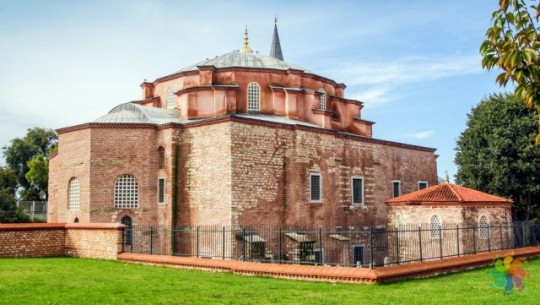
Istanbul Churches
Istanbul met Christianity in the 4th century, while, Paganism was dominant before.
The first Christian churches are Havariyyun, Haghia Sophia and Haghia Eirene. Many churches had been built until the conquest of Istanbul. There the churches of different sects and religious orders such as Nestorianism, Monophysism, Catholicism, Orthodoxy, Syrian Christianity, Gregorianism, Keldani, Dominicanism, Franciscanism has been in Istanbul. Moreover, different nations such as Greek, Armenian, Latin and Genoese also has had their own churches.
The Armenian Patriarchate
The Armenian Patriarchate in Istanbul is one of the four hierarchical centers of the Armenian Church -the others are in Erivan, Beirut and Jerusalem. The first patriarch of Istanbul, Hovaghim I, was in charge during the reign of Fatih Sultan Mehmet. Since r64i, the Virgin Mary (Meryem Ana) Central Church and the traditional wooden Patriarchate building of Istanbul Armenian Patriarchate is in Kumkapi, a harbor once called Konstancalion. Patriarchate complex (Kulliye) is twenty minutes away from Haghia Sophia, the Blue (Sultan Ahmet) Mosque and the Topkapi Palace on foot.
In 2003, all of the Istanbul Armenians will celebrate the 542*h anniversary of the foundation of the Armenian Patriarchate.
St. Anthony of Padua Catholic Church
The architect of St.Anthony Church, at Istiklal Caddesi in Pera (Beyoglu) is Cluilio Mongeri. The construction of the church that lasted six years, was completed in 1912. St. Anthony is not only one of the biggest churches in Istanbul, but also has the largest Catholic community.
The church, in a large court, is a good example of Italian neo-Gothic architecture in red brick.
St. George Fener Greek Orthodox Patriarchate Church
The Greek Orthodox Patriarchate is also in the court of the church in Fener. The Patriarchate moved to St. George (Aya Yorgi) in 1602 that was formerly a monastery. Despite of the church was severely damaged in the fire in 1941 and several other damages occurred in time, it was restorated all the time. The last restoration finished in 1991. St. George is famous with the priceless objects it houses.
The patriarchate throne believed to be from the 5th century, three mosaic icons that there are very little similar examples in the world, a column believed to be the one Jesus Christ had been fastened to and whipped, the coffins of the three saints are some of these objects.
There are few churches in Istanbul with this this type of domes. The Bell tower, built at the entrance is in classical Armenian church architecture style. The interior of the church is ornamented with tiles remained from the church that had collapsed. There are few pictures used for decoration in the church. The interior illumination is through very few and narrow windows, in accordance with Armenian church style.
Aya Istefanos
Aya Istefanos Church, also named “Bulgarian Church”, is located at Mursel Pasa Street by the shore of Golden Horn and completely made of iron casting including the columns ana mezzanine floors in it… The irons were cast in Vienna in 1871 and sent to Golden Horn via sea. The construction has a mobile quality, in other words it can be dismantled and mantled again. It can be moved to and assembled at somewhere else in case needed. The church was made by Aznavour, the famous architect of the age. The church is built for the Bulgarian minority that left Fener Greek Patriarchate, which is located on the hills of Balat. The church is still used by this community, Istanbul churches.
The tombs of the first Bulgarian patriarchs are in the garden. The church attracts the visitors with its splendor in a green and pretty garden at the shore of Golden Horn.
Sakizagaci Surp Asdvazazin Cathedral
The Armenian Church in Besiktas, Sakizagaci was built in 1866. Apart from the main altar ornamented with four columns, devoted to Virgin Mary; there are four other altars decorated with the paintings by the Roman artists. Although the annexes were seriously damaged during the fire of Perain 1870, the main church building was saved with little damage.
Ortakoy Surp Kirkor Lusavorig Church
The Armenian Catholic Church built between 1837-1838 costed 5961 golden liras then. Although partially, the architecture of the church resembles the Roman basilicas. The church has a central section and two corridors.
The fairly decorative ceilings rise over eight columns in the middle section. There is a painting on the main altar, depicting Surp (Saint) Kirkor Lusaroviq baptizi Dirtat U the king of Armenia. There are four more altars in the church.
St. Pierre Church
The Dominican priests had to move to this place down the Galata Tower owing to the fact that their original church (Arap Cami) was converted to mosque. The current building, remaining from 1841, was made by the F’ossati brothers, the Italian-Swedish originated architects who also worked for the restoration of Haghia Sophia .The rear walls of the church were built in some parts of the old Genoese city walls. There used to be a Maltese minority among the mixed people of Istanbul until recently and this church was mostly serving to them. The most important property of the building is the icon of Hodegetria (The Guiding Virgin Mary), the protector of Byzantium in a silver bowl. Behind the church are a beautiful annexed and a monastery, again in Italian style. Two more towers of the Genoese wall can be seen in the street behind the church.
A court should be passed in order to get into the church, because the front side of a building never faced the street in Ottoman order. You must ring the bell to get in.
The church was built in basilica style with its four sided altar. The sky blue dome above the chorus stage was decorated with golden gildings.
Haghia Eirene Church
“The Church of Holy Peace” is in the first court of the Topkapi Palace. It was built in the 4^ century and the oldest church in the city. It took its current form in 740 and used for storing arms and munitions during the Ottoman Empire. It has been used for exhibitions and cultural activities after the restoration.
The God Zeus, transforms his lover Io into a cow in order to avoid his wife Hera’s anger. However Hera sends a gadfly to bother this cow and Io runs from one continent to another, however cannot get rid of the gadfly, finally she jumps into the sea on a shore and swims to Asia, thus gives her name to a sea and a strait: The Bosporus, or The Ford of the Cow. It is hard to imagine while looking at its deep blue waters today that once it was the topic of a great disagreement.
The Troyan War was a war that began for the city of Troy and Argonauts that were in the quest for the Golden Fleece, had been the first human beings that passed the Bosporus. The deepest point of the Bosporus is 20m and is 33 km long; it is 660m at its narrowest while 4.7km at its widest. The predominant surface current flows from the Black Sea to the Marmara, while the main current moves towards the reverse direction.
Source: https://www.doholidays.com/istanbul-churches/
0 notes
Photo
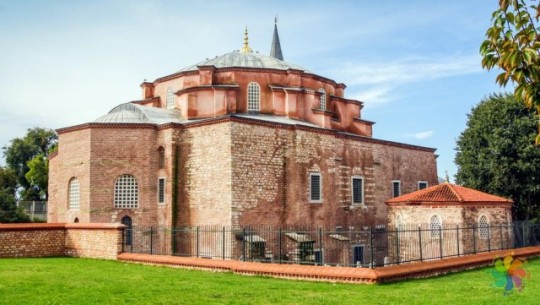
Istanbul Churches
Istanbul met Christianity in the 4th century, while, Paganism was dominant before.
The first Christian churches are Havariyyun, Haghia Sophia and Haghia Eirene. Many churches had been built until the conquest of Istanbul. There the churches of different sects and religious orders such as Nestorianism, Monophysism, Catholicism, Orthodoxy, Syrian Christianity, Gregorianism, Keldani, Dominicanism, Franciscanism has been in Istanbul. Moreover, different nations such as Greek, Armenian, Latin and Genoese also has had their own churches.
The Armenian Patriarchate
The Armenian Patriarchate in Istanbul is one of the four hierarchical centers of the Armenian Church -the others are in Erivan, Beirut and Jerusalem. The first patriarch of Istanbul, Hovaghim I, was in charge during the reign of Fatih Sultan Mehmet. Since r64i, the Virgin Mary (Meryem Ana) Central Church and the traditional wooden Patriarchate building of Istanbul Armenian Patriarchate is in Kumkapi, a harbor once called Konstancalion. Patriarchate complex (Kulliye) is twenty minutes away from Haghia Sophia, the Blue (Sultan Ahmet) Mosque and the Topkapi Palace on foot.
In 2003, all of the Istanbul Armenians will celebrate the 542*h anniversary of the foundation of the Armenian Patriarchate.
St. Anthony of Padua Catholic Church
The architect of St.Anthony Church, at Istiklal Caddesi in Pera (Beyoglu) is Cluilio Mongeri. The construction of the church that lasted six years, was completed in 1912. St. Anthony is not only one of the biggest churches in Istanbul, but also has the largest Catholic community.
The church, in a large court, is a good example of Italian neo-Gothic architecture in red brick.
St. George Fener Greek Orthodox Patriarchate Church
The Greek Orthodox Patriarchate is also in the court of the church in Fener. The Patriarchate moved to St. George (Aya Yorgi) in 1602 that was formerly a monastery. Despite of the church was severely damaged in the fire in 1941 and several other damages occurred in time, it was restorated all the time. The last restoration finished in 1991. St. George is famous with the priceless objects it houses.
The patriarchate throne believed to be from the 5th century, three mosaic icons that there are very little similar examples in the world, a column believed to be the one Jesus Christ had been fastened to and whipped, the coffins of the three saints are some of these objects.
There are few churches in Istanbul with this this type of domes. The Bell tower, built at the entrance is in classical Armenian church architecture style. The interior of the church is ornamented with tiles remained from the church that had collapsed. There are few pictures used for decoration in the church. The interior illumination is through very few and narrow windows, in accordance with Armenian church style.
Aya Istefanos
Aya Istefanos Church, also named “Bulgarian Church”, is located at Mursel Pasa Street by the shore of Golden Horn and completely made of iron casting including the columns ana mezzanine floors in it… The irons were cast in Vienna in 1871 and sent to Golden Horn via sea. The construction has a mobile quality, in other words it can be dismantled and mantled again. It can be moved to and assembled at somewhere else in case needed. The church was made by Aznavour, the famous architect of the age. The church is built for the Bulgarian minority that left Fener Greek Patriarchate, which is located on the hills of Balat. The church is still used by this community, Istanbul churches.
The tombs of the first Bulgarian patriarchs are in the garden. The church attracts the visitors with its splendor in a green and pretty garden at the shore of Golden Horn.
Sakizagaci Surp Asdvazazin Cathedral
The Armenian Church in Besiktas, Sakizagaci was built in 1866. Apart from the main altar ornamented with four columns, devoted to Virgin Mary; there are four other altars decorated with the paintings by the Roman artists. Although the annexes were seriously damaged during the fire of Perain 1870, the main church building was saved with little damage.
Ortakoy Surp Kirkor Lusavorig Church
The Armenian Catholic Church built between 1837-1838 costed 5961 golden liras then. Although partially, the architecture of the church resembles the Roman basilicas. The church has a central section and two corridors.
The fairly decorative ceilings rise over eight columns in the middle section. There is a painting on the main altar, depicting Surp (Saint) Kirkor Lusaroviq baptizi Dirtat U the king of Armenia. There are four more altars in the church.
St. Pierre Church
The Dominican priests had to move to this place down the Galata Tower owing to the fact that their original church (Arap Cami) was converted to mosque. The current building, remaining from 1841, was made by the F’ossati brothers, the Italian-Swedish originated architects who also worked for the restoration of Haghia Sophia .The rear walls of the church were built in some parts of the old Genoese city walls. There used to be a Maltese minority among the mixed people of Istanbul until recently and this church was mostly serving to them. The most important property of the building is the icon of Hodegetria (The Guiding Virgin Mary), the protector of Byzantium in a silver bowl. Behind the church are a beautiful annexed and a monastery, again in Italian style. Two more towers of the Genoese wall can be seen in the street behind the church.
A court should be passed in order to get into the church, because the front side of a building never faced the street in Ottoman order. You must ring the bell to get in.
The church was built in basilica style with its four sided altar. The sky blue dome above the chorus stage was decorated with golden gildings.
Haghia Eirene Church
“The Church of Holy Peace” is in the first court of the Topkapi Palace. It was built in the 4^ century and the oldest church in the city. It took its current form in 740 and used for storing arms and munitions during the Ottoman Empire. It has been used for exhibitions and cultural activities after the restoration.
The God Zeus, transforms his lover Io into a cow in order to avoid his wife Hera’s anger. However Hera sends a gadfly to bother this cow and Io runs from one continent to another, however cannot get rid of the gadfly, finally she jumps into the sea on a shore and swims to Asia, thus gives her name to a sea and a strait: The Bosporus, or The Ford of the Cow. It is hard to imagine while looking at its deep blue waters today that once it was the topic of a great disagreement.
The Troyan War was a war that began for the city of Troy and Argonauts that were in the quest for the Golden Fleece, had been the first human beings that passed the Bosporus. The deepest point of the Bosporus is 20m and is 33 km long; it is 660m at its narrowest while 4.7km at its widest. The predominant surface current flows from the Black Sea to the Marmara, while the main current moves towards the reverse direction.
Source: https://www.doholidays.com/istanbul-churches/
0 notes
Photo
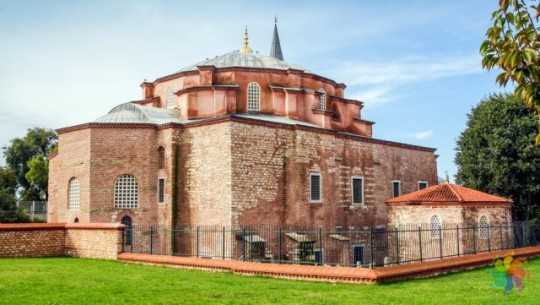
Istanbul Churches
Istanbul met Christianity in the 4th century, while, Paganism was dominant before.
The first Christian churches are Havariyyun, Haghia Sophia and Haghia Eirene. Many churches had been built until the conquest of Istanbul. There the churches of different sects and religious orders such as Nestorianism, Monophysism, Catholicism, Orthodoxy, Syrian Christianity, Gregorianism, Keldani, Dominicanism, Franciscanism has been in Istanbul. Moreover, different nations such as Greek, Armenian, Latin and Genoese also has had their own churches.
The Armenian Patriarchate
The Armenian Patriarchate in Istanbul is one of the four hierarchical centers of the Armenian Church -the others are in Erivan, Beirut and Jerusalem. The first patriarch of Istanbul, Hovaghim I, was in charge during the reign of Fatih Sultan Mehmet. Since r64i, the Virgin Mary (Meryem Ana) Central Church and the traditional wooden Patriarchate building of Istanbul Armenian Patriarchate is in Kumkapi, a harbor once called Konstancalion. Patriarchate complex (Kulliye) is twenty minutes away from Haghia Sophia, the Blue (Sultan Ahmet) Mosque and the Topkapi Palace on foot.
In 2003, all of the Istanbul Armenians will celebrate the 542*h anniversary of the foundation of the Armenian Patriarchate.
St. Anthony of Padua Catholic Church
The architect of St.Anthony Church, at Istiklal Caddesi in Pera (Beyoglu) is Cluilio Mongeri. The construction of the church that lasted six years, was completed in 1912. St. Anthony is not only one of the biggest churches in Istanbul, but also has the largest Catholic community.
The church, in a large court, is a good example of Italian neo-Gothic architecture in red brick.
St. George Fener Greek Orthodox Patriarchate Church
The Greek Orthodox Patriarchate is also in the court of the church in Fener. The Patriarchate moved to St. George (Aya Yorgi) in 1602 that was formerly a monastery. Despite of the church was severely damaged in the fire in 1941 and several other damages occurred in time, it was restorated all the time. The last restoration finished in 1991. St. George is famous with the priceless objects it houses.
The patriarchate throne believed to be from the 5th century, three mosaic icons that there are very little similar examples in the world, a column believed to be the one Jesus Christ had been fastened to and whipped, the coffins of the three saints are some of these objects.
There are few churches in Istanbul with this this type of domes. The Bell tower, built at the entrance is in classical Armenian church architecture style. The interior of the church is ornamented with tiles remained from the church that had collapsed. There are few pictures used for decoration in the church. The interior illumination is through very few and narrow windows, in accordance with Armenian church style.
Aya Istefanos
Aya Istefanos Church, also named “Bulgarian Church”, is located at Mursel Pasa Street by the shore of Golden Horn and completely made of iron casting including the columns ana mezzanine floors in it… The irons were cast in Vienna in 1871 and sent to Golden Horn via sea. The construction has a mobile quality, in other words it can be dismantled and mantled again. It can be moved to and assembled at somewhere else in case needed. The church was made by Aznavour, the famous architect of the age. The church is built for the Bulgarian minority that left Fener Greek Patriarchate, which is located on the hills of Balat. The church is still used by this community, Istanbul churches.
The tombs of the first Bulgarian patriarchs are in the garden. The church attracts the visitors with its splendor in a green and pretty garden at the shore of Golden Horn.
Sakizagaci Surp Asdvazazin Cathedral
The Armenian Church in Besiktas, Sakizagaci was built in 1866. Apart from the main altar ornamented with four columns, devoted to Virgin Mary; there are four other altars decorated with the paintings by the Roman artists. Although the annexes were seriously damaged during the fire of Perain 1870, the main church building was saved with little damage.
Ortakoy Surp Kirkor Lusavorig Church
The Armenian Catholic Church built between 1837-1838 costed 5961 golden liras then. Although partially, the architecture of the church resembles the Roman basilicas. The church has a central section and two corridors.
The fairly decorative ceilings rise over eight columns in the middle section. There is a painting on the main altar, depicting Surp (Saint) Kirkor Lusaroviq baptizi Dirtat U the king of Armenia. There are four more altars in the church.
St. Pierre Church
The Dominican priests had to move to this place down the Galata Tower owing to the fact that their original church (Arap Cami) was converted to mosque. The current building, remaining from 1841, was made by the F’ossati brothers, the Italian-Swedish originated architects who also worked for the restoration of Haghia Sophia .The rear walls of the church were built in some parts of the old Genoese city walls. There used to be a Maltese minority among the mixed people of Istanbul until recently and this church was mostly serving to them. The most important property of the building is the icon of Hodegetria (The Guiding Virgin Mary), the protector of Byzantium in a silver bowl. Behind the church are a beautiful annexed and a monastery, again in Italian style. Two more towers of the Genoese wall can be seen in the street behind the church.
A court should be passed in order to get into the church, because the front side of a building never faced the street in Ottoman order. You must ring the bell to get in.
The church was built in basilica style with its four sided altar. The sky blue dome above the chorus stage was decorated with golden gildings.
Haghia Eirene Church
“The Church of Holy Peace” is in the first court of the Topkapi Palace. It was built in the 4^ century and the oldest church in the city. It took its current form in 740 and used for storing arms and munitions during the Ottoman Empire. It has been used for exhibitions and cultural activities after the restoration.
The God Zeus, transforms his lover Io into a cow in order to avoid his wife Hera’s anger. However Hera sends a gadfly to bother this cow and Io runs from one continent to another, however cannot get rid of the gadfly, finally she jumps into the sea on a shore and swims to Asia, thus gives her name to a sea and a strait: The Bosporus, or The Ford of the Cow. It is hard to imagine while looking at its deep blue waters today that once it was the topic of a great disagreement.
The Troyan War was a war that began for the city of Troy and Argonauts that were in the quest for the Golden Fleece, had been the first human beings that passed the Bosporus. The deepest point of the Bosporus is 20m and is 33 km long; it is 660m at its narrowest while 4.7km at its widest. The predominant surface current flows from the Black Sea to the Marmara, while the main current moves towards the reverse direction.
Source: https://www.doholidays.com/istanbul-churches/
0 notes
Photo
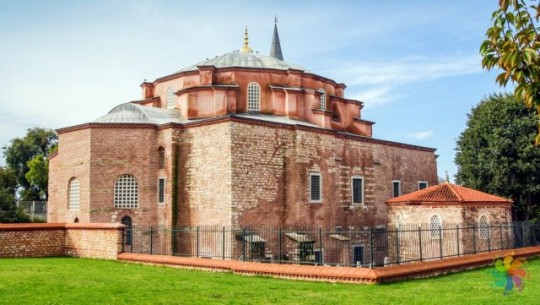
Istanbul Churches
Istanbul met Christianity in the 4th century, while, Paganism was dominant before.
The first Christian churches are Havariyyun, Haghia Sophia and Haghia Eirene. Many churches had been built until the conquest of Istanbul. There the churches of different sects and religious orders such as Nestorianism, Monophysism, Catholicism, Orthodoxy, Syrian Christianity, Gregorianism, Keldani, Dominicanism, Franciscanism has been in Istanbul. Moreover, different nations such as Greek, Armenian, Latin and Genoese also has had their own churches.
The Armenian Patriarchate
The Armenian Patriarchate in Istanbul is one of the four hierarchical centers of the Armenian Church -the others are in Erivan, Beirut and Jerusalem. The first patriarch of Istanbul, Hovaghim I, was in charge during the reign of Fatih Sultan Mehmet. Since r64i, the Virgin Mary (Meryem Ana) Central Church and the traditional wooden Patriarchate building of Istanbul Armenian Patriarchate is in Kumkapi, a harbor once called Konstancalion. Patriarchate complex (Kulliye) is twenty minutes away from Haghia Sophia, the Blue (Sultan Ahmet) Mosque and the Topkapi Palace on foot.
In 2003, all of the Istanbul Armenians will celebrate the 542*h anniversary of the foundation of the Armenian Patriarchate.
St. Anthony of Padua Catholic Church
The architect of St.Anthony Church, at Istiklal Caddesi in Pera (Beyoglu) is Cluilio Mongeri. The construction of the church that lasted six years, was completed in 1912. St. Anthony is not only one of the biggest churches in Istanbul, but also has the largest Catholic community.
The church, in a large court, is a good example of Italian neo-Gothic architecture in red brick.
St. George Fener Greek Orthodox Patriarchate Church
The Greek Orthodox Patriarchate is also in the court of the church in Fener. The Patriarchate moved to St. George (Aya Yorgi) in 1602 that was formerly a monastery. Despite of the church was severely damaged in the fire in 1941 and several other damages occurred in time, it was restorated all the time. The last restoration finished in 1991. St. George is famous with the priceless objects it houses.
The patriarchate throne believed to be from the 5th century, three mosaic icons that there are very little similar examples in the world, a column believed to be the one Jesus Christ had been fastened to and whipped, the coffins of the three saints are some of these objects.
There are few churches in Istanbul with this this type of domes. The Bell tower, built at the entrance is in classical Armenian church architecture style. The interior of the church is ornamented with tiles remained from the church that had collapsed. There are few pictures used for decoration in the church. The interior illumination is through very few and narrow windows, in accordance with Armenian church style.
Aya Istefanos
Aya Istefanos Church, also named “Bulgarian Church”, is located at Mursel Pasa Street by the shore of Golden Horn and completely made of iron casting including the columns ana mezzanine floors in it… The irons were cast in Vienna in 1871 and sent to Golden Horn via sea. The construction has a mobile quality, in other words it can be dismantled and mantled again. It can be moved to and assembled at somewhere else in case needed. The church was made by Aznavour, the famous architect of the age. The church is built for the Bulgarian minority that left Fener Greek Patriarchate, which is located on the hills of Balat. The church is still used by this community, Istanbul churches.
The tombs of the first Bulgarian patriarchs are in the garden. The church attracts the visitors with its splendor in a green and pretty garden at the shore of Golden Horn.
Sakizagaci Surp Asdvazazin Cathedral
The Armenian Church in Besiktas, Sakizagaci was built in 1866. Apart from the main altar ornamented with four columns, devoted to Virgin Mary; there are four other altars decorated with the paintings by the Roman artists. Although the annexes were seriously damaged during the fire of Perain 1870, the main church building was saved with little damage.
Ortakoy Surp Kirkor Lusavorig Church
The Armenian Catholic Church built between 1837-1838 costed 5961 golden liras then. Although partially, the architecture of the church resembles the Roman basilicas. The church has a central section and two corridors.
The fairly decorative ceilings rise over eight columns in the middle section. There is a painting on the main altar, depicting Surp (Saint) Kirkor Lusaroviq baptizi Dirtat U the king of Armenia. There are four more altars in the church.
St. Pierre Church
The Dominican priests had to move to this place down the Galata Tower owing to the fact that their original church (Arap Cami) was converted to mosque. The current building, remaining from 1841, was made by the F’ossati brothers, the Italian-Swedish originated architects who also worked for the restoration of Haghia Sophia .The rear walls of the church were built in some parts of the old Genoese city walls. There used to be a Maltese minority among the mixed people of Istanbul until recently and this church was mostly serving to them. The most important property of the building is the icon of Hodegetria (The Guiding Virgin Mary), the protector of Byzantium in a silver bowl. Behind the church are a beautiful annexed and a monastery, again in Italian style. Two more towers of the Genoese wall can be seen in the street behind the church.
A court should be passed in order to get into the church, because the front side of a building never faced the street in Ottoman order. You must ring the bell to get in.
The church was built in basilica style with its four sided altar. The sky blue dome above the chorus stage was decorated with golden gildings.
Haghia Eirene Church
“The Church of Holy Peace” is in the first court of the Topkapi Palace. It was built in the 4^ century and the oldest church in the city. It took its current form in 740 and used for storing arms and munitions during the Ottoman Empire. It has been used for exhibitions and cultural activities after the restoration.
The God Zeus, transforms his lover Io into a cow in order to avoid his wife Hera’s anger. However Hera sends a gadfly to bother this cow and Io runs from one continent to another, however cannot get rid of the gadfly, finally she jumps into the sea on a shore and swims to Asia, thus gives her name to a sea and a strait: The Bosporus, or The Ford of the Cow. It is hard to imagine while looking at its deep blue waters today that once it was the topic of a great disagreement.
The Troyan War was a war that began for the city of Troy and Argonauts that were in the quest for the Golden Fleece, had been the first human beings that passed the Bosporus. The deepest point of the Bosporus is 20m and is 33 km long; it is 660m at its narrowest while 4.7km at its widest. The predominant surface current flows from the Black Sea to the Marmara, while the main current moves towards the reverse direction.
Source: https://www.doholidays.com/istanbul-churches/
0 notes
Photo
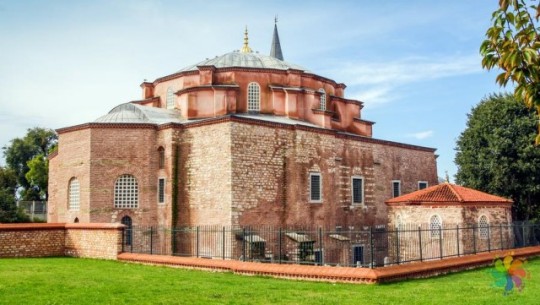
Istanbul Churches
Istanbul met Christianity in the 4th century, while, Paganism was dominant before.
The first Christian churches are Havariyyun, Haghia Sophia and Haghia Eirene. Many churches had been built until the conquest of Istanbul. There the churches of different sects and religious orders such as Nestorianism, Monophysism, Catholicism, Orthodoxy, Syrian Christianity, Gregorianism, Keldani, Dominicanism, Franciscanism has been in Istanbul. Moreover, different nations such as Greek, Armenian, Latin and Genoese also has had their own churches.
The Armenian Patriarchate
The Armenian Patriarchate in Istanbul is one of the four hierarchical centers of the Armenian Church -the others are in Erivan, Beirut and Jerusalem. The first patriarch of Istanbul, Hovaghim I, was in charge during the reign of Fatih Sultan Mehmet. Since r64i, the Virgin Mary (Meryem Ana) Central Church and the traditional wooden Patriarchate building of Istanbul Armenian Patriarchate is in Kumkapi, a harbor once called Konstancalion. Patriarchate complex (Kulliye) is twenty minutes away from Haghia Sophia, the Blue (Sultan Ahmet) Mosque and the Topkapi Palace on foot.
In 2003, all of the Istanbul Armenians will celebrate the 542*h anniversary of the foundation of the Armenian Patriarchate.
St. Anthony of Padua Catholic Church
The architect of St.Anthony Church, at Istiklal Caddesi in Pera (Beyoglu) is Cluilio Mongeri. The construction of the church that lasted six years, was completed in 1912. St. Anthony is not only one of the biggest churches in Istanbul, but also has the largest Catholic community.
The church, in a large court, is a good example of Italian neo-Gothic architecture in red brick.
St. George Fener Greek Orthodox Patriarchate Church
The Greek Orthodox Patriarchate is also in the court of the church in Fener. The Patriarchate moved to St. George (Aya Yorgi) in 1602 that was formerly a monastery. Despite of the church was severely damaged in the fire in 1941 and several other damages occurred in time, it was restorated all the time. The last restoration finished in 1991. St. George is famous with the priceless objects it houses.
The patriarchate throne believed to be from the 5th century, three mosaic icons that there are very little similar examples in the world, a column believed to be the one Jesus Christ had been fastened to and whipped, the coffins of the three saints are some of these objects.
There are few churches in Istanbul with this this type of domes. The Bell tower, built at the entrance is in classical Armenian church architecture style. The interior of the church is ornamented with tiles remained from the church that had collapsed. There are few pictures used for decoration in the church. The interior illumination is through very few and narrow windows, in accordance with Armenian church style.
Aya Istefanos
Aya Istefanos Church, also named “Bulgarian Church”, is located at Mursel Pasa Street by the shore of Golden Horn and completely made of iron casting including the columns ana mezzanine floors in it… The irons were cast in Vienna in 1871 and sent to Golden Horn via sea. The construction has a mobile quality, in other words it can be dismantled and mantled again. It can be moved to and assembled at somewhere else in case needed. The church was made by Aznavour, the famous architect of the age. The church is built for the Bulgarian minority that left Fener Greek Patriarchate, which is located on the hills of Balat. The church is still used by this community, Istanbul churches.
The tombs of the first Bulgarian patriarchs are in the garden. The church attracts the visitors with its splendor in a green and pretty garden at the shore of Golden Horn.
Sakizagaci Surp Asdvazazin Cathedral
The Armenian Church in Besiktas, Sakizagaci was built in 1866. Apart from the main altar ornamented with four columns, devoted to Virgin Mary; there are four other altars decorated with the paintings by the Roman artists. Although the annexes were seriously damaged during the fire of Perain 1870, the main church building was saved with little damage.
Ortakoy Surp Kirkor Lusavorig Church
The Armenian Catholic Church built between 1837-1838 costed 5961 golden liras then. Although partially, the architecture of the church resembles the Roman basilicas. The church has a central section and two corridors.
The fairly decorative ceilings rise over eight columns in the middle section. There is a painting on the main altar, depicting Surp (Saint) Kirkor Lusaroviq baptizi Dirtat U the king of Armenia. There are four more altars in the church.
St. Pierre Church
The Dominican priests had to move to this place down the Galata Tower owing to the fact that their original church (Arap Cami) was converted to mosque. The current building, remaining from 1841, was made by the F’ossati brothers, the Italian-Swedish originated architects who also worked for the restoration of Haghia Sophia .The rear walls of the church were built in some parts of the old Genoese city walls. There used to be a Maltese minority among the mixed people of Istanbul until recently and this church was mostly serving to them. The most important property of the building is the icon of Hodegetria (The Guiding Virgin Mary), the protector of Byzantium in a silver bowl. Behind the church are a beautiful annexed and a monastery, again in Italian style. Two more towers of the Genoese wall can be seen in the street behind the church.
A court should be passed in order to get into the church, because the front side of a building never faced the street in Ottoman order. You must ring the bell to get in.
The church was built in basilica style with its four sided altar. The sky blue dome above the chorus stage was decorated with golden gildings.
Haghia Eirene Church
“The Church of Holy Peace” is in the first court of the Topkapi Palace. It was built in the 4^ century and the oldest church in the city. It took its current form in 740 and used for storing arms and munitions during the Ottoman Empire. It has been used for exhibitions and cultural activities after the restoration.
The God Zeus, transforms his lover Io into a cow in order to avoid his wife Hera’s anger. However Hera sends a gadfly to bother this cow and Io runs from one continent to another, however cannot get rid of the gadfly, finally she jumps into the sea on a shore and swims to Asia, thus gives her name to a sea and a strait: The Bosporus, or The Ford of the Cow. It is hard to imagine while looking at its deep blue waters today that once it was the topic of a great disagreement.
The Troyan War was a war that began for the city of Troy and Argonauts that were in the quest for the Golden Fleece, had been the first human beings that passed the Bosporus. The deepest point of the Bosporus is 20m and is 33 km long; it is 660m at its narrowest while 4.7km at its widest. The predominant surface current flows from the Black Sea to the Marmara, while the main current moves towards the reverse direction.
Source: https://www.doholidays.com/istanbul-churches/
0 notes